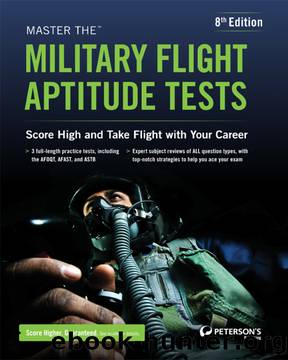Master the Military Flight Aptitude Tests by Peterson's

Author:Peterson's
Language: eng
Format: epub
Publisher: Peterson's
Published: 2012-06-28T00:00:00+00:00
Aviation Information
Questions are in the Aviation Information section of this chapter.
1. The correct answer is (B). The upward angle formed by the wings, called dihedral, counteracts any balance upset caused by a gust of wind and returns the airplane to a wing-level attitude.
2. The correct answer is (A). The flight path and relative wind are parallel but travel in opposite directions. If an airfoil moves forward and upward, the relative wind moves backward and downward.
3. The correct answer is (C). The lift and drag acting on a wing are proportional to the wing area. If the wing area is doubled and the other variables remain the same, the lift and drag created by the wing will be doubled.
4. The correct answer is (D). Tetraethyl lead is the best available knock inhibitor. It is added to improve the antiknock quality of a fuel.
5. The correct answer is (A). The standard weight for gasoline is 6 lbs./U.S. gal., that for oil is 7.5 lbs./U.S. gal., and that for water is 8.35 lbs./U.S. gal.
6. The correct answer is (B). Bernocilliâs principle and Newtonâs third law of motion are the basis for explaining how an airplane wing produces lift.
7. The correct answer is (A). The rearward or retarding force acting on an airplane during flight is called drag.
8. The correct answer is (A). The angle of attack is the angle between the chord line of the airfoil and the direction of the relative wind.
9. The correct answer is (D). Lift varies directly with the density of air. As the density of air increases, lift and drag increase.
10. The correct answer is (E). The trailing edge of the airfoil or wing is the aft end of the airfoil, where the airflow over the upper surface meets the airflow from the lower surface.
11. The correct answer is (D). The empennage is the tail section and generally consists of a vertical stabilizer, a horizontal stabilizer, a movable rudder, and a movable elevator.
12. The correct answer is (A). The ailerons, located on the rear edge of the wings near the outer tips, are used to bank or roll the airplane around its longitudinal axis.
13. The correct answer is (A). The pitot is used to ascertain the impact pressure of the air as the airplane moves forward.
14. The correct answer is (C). Applying forward pressure on the control causes the elevator surfaces to move downward. The flow of air striking the deflected surfaces exerts an upward force, pushing the airplaneâs tail upward and the nose downward.
15. The correct answer is (D). Runway numbers are different at each end of the runway strip because the magnetic directions are 180 degrees apart. The approximate magnetic direction for runway numbered 3 is 30 degrees. The other end would be numbered 21 as it has a magnetic direction of 210 degrees.
16. The correct answer is (C). The tower operator uses a flashing red signal to instruct pilots not to land because the airport is unsafe.
17. The correct answer is (D). White lights are used to illuminate airport runways.
Download
This site does not store any files on its server. We only index and link to content provided by other sites. Please contact the content providers to delete copyright contents if any and email us, we'll remove relevant links or contents immediately.
Navigation and Map Reading by K Andrew(5111)
Spare by Prince Harry The Duke of Sussex(5072)
Tuesdays with Morrie by Mitch Albom(4690)
Cracking the GRE Premium Edition with 6 Practice Tests, 2015 (Graduate School Test Preparation) by Princeton Review(4224)
Machine Learning at Scale with H2O by Gregory Keys | David Whiting(4177)
Never by Ken Follett(3789)
Goodbye Paradise(3727)
What It Really Takes to Get Into Ivy League and Other Highly Selective Colleges by Hughes Chuck(3696)
Harry Potter and the Prisoner of Azkaban (Book 3) by J. K. Rowling(3304)
Fairy Tale by Stephen King(3220)
Pledged by Alexandra Robbins(3132)
Kick Ass in College: Highest Rated "How to Study in College" Book | 77 Ninja Study Skills Tips and Career Strategies | Motivational for College Students: A Guerrilla Guide to College Success by Fox Gunnar(3075)
A Dictionary of Sociology by Unknown(3031)
Sapiens and Homo Deus by Yuval Noah Harari(2987)
Reminders of Him: A Novel by Colleen Hoover(2943)
The Social Psychology of Inequality by Unknown(2939)
Graduate Admissions Essays, Fourth Edition: Write Your Way into the Graduate School of Your Choice (Graduate Admissions Essays: Write Your Way Into the) by Asher Donald(2876)
Will by Will Smith(2791)
Zero to Make by David Lang(2726)
